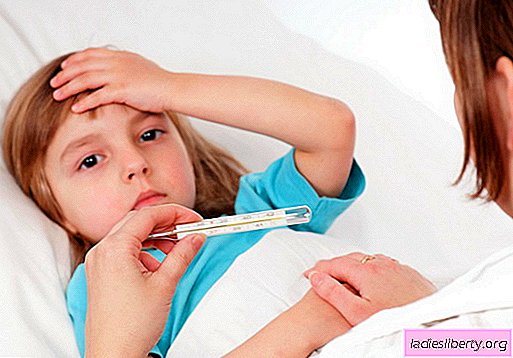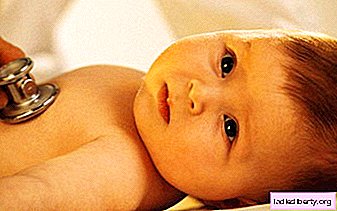
The creeping of the thermometer over the 37 degrees mark in many mummies causes a slight panic. And if the temperature of the baby is 38 and above, in the complete absence of any additional signs, then the anxieties and feelings of the parents going off scale.
Sometimes a light heat is a completely normal reaction of the child's body to external stimuli, but there are also not so harmless situations. Therefore, parents should be aware of the possible causes of asymptomatic fever and be able to make the right decisions.
The main causes of temperature without additional symptoms
1. Overheating
The first five years, the child's thermoregulation is not well developed. The banal reasons can lead to a slight increase in temperature indicators:
- long stay of the baby in a hot and stuffy room;
- aggressive summer sun;
- too warm and too tight clothes;
- long and overly active games;
- Baby wrap and long stroller in the sun.
In these cases, the temperature can rise from 37 to 38.5 degrees. Mom should put the baby in the shade, remove excess clothing, give a drink and wipe the body of the child with cool water, the room needs to be well ventilated. If the reason for the increase in temperature was overheating, the thermometer will drop to normal numbers within an hour.
2. Teeth cut
Some children frighten parents with the presence of anomalous temperature due to teething, although on this occasion the opinions of doctors differ. However, if mommy saw swollen reddened gums, and the baby is restless and does not want to eat, this may be one of the reasons. The maximum mark on the thermometer can be 38 ° C, this figure is usually present for 2-3 days. To alleviate the condition of the sufferer will help special anesthetic gels, abundant heat, the cancellation of too mobile games and, of course, increased attention and caressing mothers.
3. Reaction to vaccination
Some children give a feverish response to the vaccine. However, in this case, the baby does not experience any additional discomfort, although the temperature can rise to 38-38.5 degrees and last for 2-3 days.
4. The presence of a viral infection
On the first day, an insidious virus is able to manifest itself only by the presence of a fairly high temperature, causing mom to worry and sort out possible variants of its causes. But on the second or third day, symptoms associated with the disease appear - cough, runny nose, rash, or reddened throat, which indicate specifically a viral infection. You should not hurry to beat down the temperature with medical preparations, it is better to create comfortable conditions for effectively combating the child’s body with it - to provide plenty of drinks, fresh air and a temperature of 20-22 degrees in the room, rest for the child. Wet wiping of the skin, timely change of sweaty clothes, attention and quiet communication will facilitate the child's condition. Remember! Antibiotics for viral infection are ineffective.
5. Sudden rash
Viral infections include the disease, which is most susceptible to babies from 9 to 24 months. Caused by the illness of the herpes virus and manifested by fever, a temperature of 38.5-40 degrees without other symptoms. However, soon a maculopapular rash appears, possibly enlarged lymph nodes - cervical, submandibular, occipital. All manifestations of the disease disappear in about 5-6 days.
5. Bacterial infection
After acute respiratory viral infections, and sometimes independently, a bacterial infection may occur. It is characterized by a number of symptoms that only a doctor can sometimes notice on the first day of the illness. Diseases caused by this cause include:
- sore throat - plaque and pustules on tonsils, pain when swallowing, high fever. Children are ill only older than a year, most often after two years;
- stomatitis - refusal to feed, salivation, fever, blisters and sores on the oral mucosa;
- otitis - the child does not eat, is naughty, grabs the sore ear, the temperature is elevated;
- pharyngitis - the baby’s neck is red with rashes and sores on it;
- infections of the genitourinary system - quite often occur in children up to three years. Sometimes not very pleasant signs join the increased temperature - pain during urination and its increase. To clarify the diagnosis will need to do a laboratory study of urine.
Other possible causes of fever in children, in the absence of other symptoms, are congenital heart defects, inflamed wounds on the skin or mucous membranes, and allergic reactions.
What to do mom if the child feels without symptoms
Any increase in temperature is a sign of the struggle of the child's body with uninvited infections or adverse external influences. Do not panic and immediately give antipyretic. First of all, it is necessary to measure the temperature, not relying on tactile sensations. If the baby does not have congenital anomalies or chronic diseases, the mother’s actions are as follows:
- at a temperature of 37-37.5 degrees, drug exposure is not required, the body tries to cope with the problem on its own;
- if the thermometer readings are in the range of 37.5 - 38.5 degrees, only physical intervention is required from the mother - wet rubbing up the baby, airing the room, ensuring abundant warm drinking;
- A temperature of 38.5 degrees and above requires antipyretic drugs. Most often, children give panadol, nurofen and other drugs. Each mother should be prepared for a similar situation and, after prior consultation with the doctor, have the necessary means in the first-aid kit.
If the temperature drops quickly after taking an antipyretic, but soon rises again and remains at the same level, this may indicate a viral infection - measles, chickenpox, rubella. In such cases, you should invite the doctor to the house.
Fever without symptoms - when to see a doctor
If the temperature remains high on the fourth or fifth day, it is necessary to show the child to the pediatrician. A symptom may indicate the presence of a nidus of inflammation or a bacterial infection. Blood and urine tests will help the doctor clarify the picture and prescribe an effective treatment. But there are situations when the help of a specialist is required immediately. Call the ambulance service if your baby:
- sharp pallor and lethargy;
- difficulty breathing;
- temperature increase in the presence of antipyretic drugs;
- cramps.
Be attentive to the baby, do not leave it unattended if there are no obvious signs of any disease at elevated temperatures. Mom's task - to help the child cope with an unusual state and find out its cause.
Low-grade fever - what does it mean
Sometimes the toddler feels quite comfortable, does not present any complaints, and only a random measurement of temperature reveals its increase in the range of 37-38 degrees. This condition can last for a whole month, and is defined by doctors as subfebrile temperature. The apparent external well-being can be deceptive, as a prolonged rise in temperature signals about problems in the children's body, which flow is hidden. There are a lot of diseases characterized in this way - anemia and worm infestation, allergies and diabetes, brain diseases and various latent infections. Detect them will help special diagnostic studies and analyzes.
Considering the constant stress that a fragile children's body experiences under the influence of constantly increased temperature, it is not worth delaying a visit to the doctor. It may be necessary to consult such specialists as an endocrinologist, a neuropathologist, an otolaryngologist, an immunologist. Only after having carefully examined the baby, will it be possible to correctly diagnose and prescribe the necessary treatment. The reason for low-grade fever can be a decrease in immunity, impaired thermoregulation, infectious and inflammatory processes.
If the diagnosis eliminates the presence of hidden infections, attention should be paid to increasing the protective forces of the child’s body. Hardening, long walks in the fresh air, good nutrition, sound healthy sleep - all these measures will increase immunity and allow you to return to normal readings of the thermometer.
Temperature without symptoms in an infant
Newborn crumbs do not have a well-established system of thermoregulation, so the temperature of 37-37.5 degrees in babies should not cause concern. Of course, in the event that the baby eats with appetite, sleeps soundly and is not capricious. When the temperature rises you should not resort to the use of medications, it is better to seek the advice of a doctor. To avoid overheating, you do not need to bundle up the baby and neglect the ventilation of the room.
Dr. Komarovsky about temperature without symptoms
The doctor, who is trusted by the vast majority of young mummies, believes that in summer the main reason for the rise in temperature without associated symptoms is banal overheating, and in the cold season - viral infections. Usually, half of the parents in such cases immediately consult a doctor, the rest prefer to wait a little while watching the baby. If a mother takes a doctor as adviser, then there are already two of them in the struggle for the health of the child, which is always safer and better. In case of waiting for the appearance of certain signs, you need to remember the reasons why contacting a medical institution becomes mandatory:
1. On the third day after the temperature has risen, improvement is not observed, that is, the thermometer has not dropped even a few divisions.
2. On the fifth day, the temperature still holds, whereas it should already become normal.
Fighting the disease should not begin with syrups, lowering the fever, but with room moistening, regular ventilation and drinking plenty of water. That is, it is necessary to create the most comfortable conditions so that the baby's body can fight the disease.
The reasons for the increase in temperature, Dr. Komarovsky divides into:
- non-infectious - overheating;
- viral infections that pass on their own. A distinctive feature is bright pink skin;
- bacterial infections - accompanied by certain symptoms that can make themselves felt immediately, - rash, diarrhea, sore throat or ear. The skin is usually pale, and the baby is limp and indifferent. This is almost one hundred percent confirmation of the diagnosis, due to the release of toxins by bacteria. In these cases, doctors use antibiotic treatment to help effectively deal with the problem.
Yevgeny Komarovsky believes that simply raising the temperature often does not pose a particular threat, but in order not to blame himself for slowness, it is better to consult a doctor.











